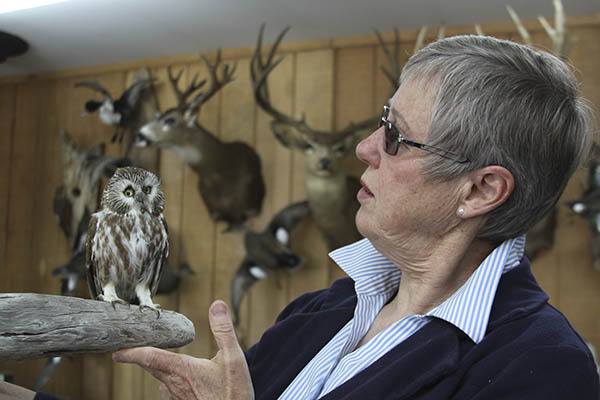On any given day, Robin Llewellyn can reach into the freezer compartment beneath her refrigerator and pull out a frozen surprise.
Sometimes, it’ll be a bag of cranberries, sugar snap peas or free range chicken.
Other times, it’ll be something altogether different.
“I have a pintail duck,” Llewellyn said as she checked her freezer inventory Monday. “It’s very heavy.”
Llewellyn continued the search.
“I have a goldfinch, a male,” she said. “I have a varied thrush. Here’s another couple of birds. I didn’t know I had all these in here. Here’s a house wren. A spotted towhee. I have a barn owl. What else do I have in here?”
Llewellyn, who lives in Greenbank, can’t remember the last time she worried about sharing freezer space with dead birds.
It’s part of the territory that comes with being program chair of the Whidbey Audubon Society, a role she’s held for nine years.
With this title, she also eagerly embraces the designation as chief bird specimen collector on Whidbey Island, which explains the contents of her freezer.
“I’m so far past thinking of them as being something that’s icky,” Llewellyn said.
The Whidbey Audubon Society has assembled an enormous collection of dead birds, which the group uses to educate the public.
Every two years, the preserved birds go on display for birding enthusiasts and other curious people to examine closely and to handle.
The next opportunity will take place from 10 a.m.-1 p.m. Saturday, June 14, inside the barn at Greenbank Farm.
The free event, called “Bird in Hand,” also will include a live raptor or two on the arms of their trainers.
Llewellyn came up with the idea to let birders get an intimate look at dead birds seven years ago.
The idea seemed to have merit since many bird enthusiasts go through great effort in the field to get as close as possible to the birds they study.
But it took hundreds of hours from Audubon Society volunteers for the event to take flight.
To get the birds ready for the exhibit, volunteers have had to gain an education in skinning, preserving, pinning and mounting birds.
That expertise was gained from Matt Klope, an Oak Harbor taxidermist and U.S. Naval wildlife biologist who’s taught volunteers the tedious process of preparing the birds.
“It’s so important that you get upclose and personal,” Klope said of the Audubon program. “You can look through spotting scopes to see things like feather patterns and bill length. But now you’ve got them in your hands.”
The Whidbey Audubon Society is only able to keep and display the dead birds because of a federal permit that allows the group to use the collection for educational purposes, Klope said.
Klope said he gets calls all the time from people wanting him to stuff an owl or hawk that was found on the side of the road.
Federal law, under the Migratory Bird Treaty Act, prohibits that.
“I can’t accept a bird without a permit,” he said. “It has to be for educational purposes.”
The Whidbey Audubon’s collection consists of about 450 individual specimens representing 115 species from waterfowl, raptors, shorebirds and songbirds.
Nearly all of the birds were found on Whidbey, often casualties of windows, cats or cars.
When a dead bird is discovered, members are told to freeze the specimen in a plastic bag containing a piece of paper that records who found the bird, the date it was found and where it was discovered.
Ultimately, the specimen is handed off to Llewellyn and eventually winds up at Klope’s Whidbey Island Taxidermy shop in Oak Harbor where preservation takes place.
The Whidbey Audubon Society’s collection is considered museum-quality, prepared by specially-trained members such as Sarah Schmidt of Coupeville. Select museums have access to the collection.
And although the collection includes various species of owls, hawks and falcons, federal law prohibits the inclusion of eagles.
“All eagles go to the National Eagle Repository in Colorado,” Klope said.
Klopes keeps the collection at his home shop. When he retires as a biologist, he’ll devote his full attention to preserving wildlife specimens and one day would like to open an interpretive center with stuffed birds on display.
Until then, he and Whidbey Audubon will continue to build on their bird collection, which currently represents about half of the bird species on the island.
And Llewellyn will continue to surprise her grandchildren with the things she stores in her freezer.
“They know how it is at grandma’s house,” she said.


